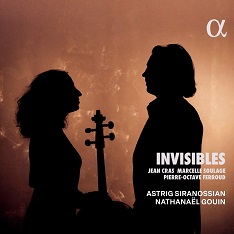Erste Feststellung: der Klang dieses Albums ist höchst unangenehm, aufgedunsen, mit einem kaum konturierten und mulmigen Celloklang. In der Vergleichsaufnahme (Cras-Sonate) mit Alexandre Khramouchin und Alain Jacquon klingt das Cello schlanker und präziser.
Das Programm beginnt mit dieser Cellosonate von Jean Cras (1879-1932), der zum Zeitpunkt der Komposition Fähnrich auf dem Schlachtschiff Saint-Louis war, wo er, wie er sich ausdrückte, seiner inneren Stimme folgte, die ihn zum Komponieren anregte.
Astrig Siranossian und Nathanaël Gouin spielen gleich mit leidenschaftlichem Elan, vibrierend und sinnlich, um uns von den Gemütszuständen des Komponisten zu erzählen.
Der zweite Satz badet in Melancholie, die wir zeitweise im Finale wiederfinden, das mit seinen kräftigen Akzenten überrascht. Die wilden Eskapaden dieses dritten Satzes entführen uns in eine Welt, in der alle Metamorphosen möglich sind, in der Träume und Staunen immer wieder neu entstehen.
Von Pierre-Octave Ferroud (1900-36), einem Schüler von Florent Schmitt, wird gesagt, er sei unter den französischen Komponisten einzigartig in seiner Fähigkeit, die Farben des Impressionismus mit dem Neoklassizismus zu verbinden. Damit gelangen ihm Kompositionen wie seine Cellosonate, die sowohl bezaubernd als auch eindringlich ist wegen der erfolgreichen Gratwanderung zwischen Ironie und Verspieltheit, zwischen Ernst und Unbekümmertheit. Sie ist auf diesem Album in einer lebendig-inspirierten Interpretation zu hören.
Marcelle Soulage (1894-1970), eine Schülerin von Vincent D’Indy, and Nadia Boulanger, erhielt im Jahre 1920 den Prix des Amis de la Musique für ihre Cellosonate. Diese beginnt mit einem gestischen Allegro moderato, auf den ein hier ergreifend gespieltes Nocturne folgt, ehe ein wirbelndes Allegro vivo die Sonate beendet.
First observation: the sound of this album is highly unpleasant, bloated, with a barely contoured and queasy cello sound. In the comparison recording (Cras Sonata) with Alexandre Khramouchin and Alain Jacquon, the cello sounds leaner and more precise.
The program begins with this Cello Sonata by Jean Cras (1879-1932), who was a midshipman on the battleship Saint-Louis at the time of composition. There, as he put it, he followed his inner voice, which inspired him to compose. Astrig Siranossian and Nathanaël Gouin immediately play with passionate vigor, vibrant and sensual, to tell us about the composer’s state of mind. The second movement is bathed in melancholy, which we find again at times in the finale, which surprises us with its powerful accents. The wild escapades of this third movement transport us to a world in which all metamorphoses are possible, in which dreams and wonder are constantly renewed.
Pierre-Octave Ferroud (1900-36), a pupil of Florent Schmitt, is said to be unique among French composers in his ability to combine the colors of impressionism with neoclassicism. He thus achieved compositions such as his Cello Sonata, which is both enchanting and haunting because of its successful balancing act between irony and playfulness, between seriousness and light-heartedness. It can be heard on this album in a lively and inspired interpretation.
Marcelle Soulage (1894-1970), a pupil of Vincent D’Indy and Nadia Boulanger, was awarded the Prix des Amis de la Musique for her cello sonata in 1920. It begins with a gestural Allegro moderato, followed by a moving Nocturne, before a whirling Allegro vivo ends the sonata.


















